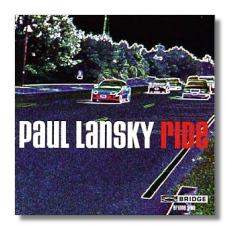
The Internet's Premier Classical Music Source
Related Links
- Latest Reviews
- More Reviews
-
By Composer
-
Collections
DVD & Blu-ray
Books
Concert Reviews
Articles/Interviews
Software
Audio
Search Amazon
Recommended Links
Site News
 CD Review
CD Review
Paul Lansky

Ride
- Idle Chatter Junior
- Ride
- Looking Back
- Heavy Set
- Dancetracks: Remix
Paul Lansky, computers, etc.
Bridge 9103 DDD 64:03
I always welcome a new CD from Paul Lansky, a staple of the Bridge Records catalog since 1992 and the release of his Homebrew CD (Bridge 9035). It is easy to hate computers when they eat a crucial text file or when they don't allow you to take your money out of the ATM. (Ironically, my computer crashed as I was trying to finish this review!) Lansky's music, although it has been created by virtue of some highfalutin' computer technology, is all about giving human beings enjoyable stimulation and positive vibes.
I suspect that Lansky, a faculty member at Princeton University, prefers not to be pigeon-holed. "I look forward to the day," he writes in the booklet notes, "when nobody will care whether or not a computer was used in the process of making a piece." He continues, "If any kind of music is to survive, it has to hide its technology, so, to my mind, 'Computer Music' should become irrelevant as a category." Still, for many, the medium is the message, and it can be as hard to sell traditional orchestral music to children of the Computer Age as it is to sell electronic and "computer-assisted" music to senescent classicos.
Lansky revisits familiar territory on this CD, which includes five newish creations. Idle Chatter Junior is the fourth in a series of "Idle Chatter" works; the previous three can be found on More Than Idle Chatter (Bridge 9050). Improvements in the technology used to create the three earlier works stimulated Lansky to create this sequel more than ten years after its immediate predecessor. Here, as before, Lansky takes a speaking voice (or voices), chops it into bite-sized (byte-sized?) pieces, throws the pieces into the blender, and puts the pieces back together again in a manner that suggests melody, harmony, and rhythm. Imagine losing your ability to understand speech and then being taken to a crowded cocktail party. That's Idle Chatter Junior, The sensation of hearing words but not being able to construct a conversation out of them might tease listeners, but it's a good teasing. Lansky cleverly varies the pace and the density of this piece to sustain listener interest over its ten-minute span.
Ride, the title work, is a descendent of Night Traffic, which was included on the Homebrew CD. In both works, Lansky takes the sounds of traffic, finds their inherent musicality, and makes a somewhat surreal, impressionist landscape from them. Night Traffic kept the listener stationary as traffic zoomed by on a highway. In Ride, he puts the listener in the passenger seat, as it were, and takes the long way home. The almost symphonic drone of cars and trucks, sometimes distant and sometimes moving rapidly across the sound-field, is awesome but pleasant, no matter how expensive gas is. En route, Lansky takes the listener through rural and suburban environments. What the listener "sees" on this trip is fairly subjective. Human voices, usually processed beyond comprehension, appear in this work as well.
Looking Back holds a surprise: part of the finale from Brahms' First Symphony. It seems that the famous C-major melody, set to words, was the school song of the High School of Music and Art in New York City, of which Lansky is an alumnus. This is Lansky at his most sentimental – some might say sappy. The music shimmers like a desert mirage, never really graspable, but tantalizingly within reach. The tunes, of course, are great.
For Heavy Set, Lansky "designed a computer model of the right hand of an imaginary (and very large) improvising pianist." This model attempted "to think as a pianist might as he moves around the keyboard, listening to the concurrent harmonies, deciding when to add non-harmonic tones, play chords, go up, go down, play loud, soft, lyrically, firmly, and so on." The "right hand" dances with agility in a warm bed of "string" sounds. This is the sound of a cyber-hyperpianist, jamming in a dark auditorium, or perhaps a jazz club, after all the patrons have gone home.
The disc ends with Dancetracks: Remix, Lansky's revisitation of Dancetracks, a collaborative work with guitarist Steve Mackey that can be heard on Mackey's Lost & Found CD (Bridge 9065). Lansky liked the work so much he decided to "remix" Mackey's guitar part and add a new computer part of his own. Unlike some remixes in the world of popular music, Dancetracks: Remix stands on its own, both for Mackey's impressive (and polystylic) guitar-playing and for Lansky's imaginative treatment of the same. You don't have to be familiar with the original work to appreciate this, although the two works definitely complement each other.
While Lansky's Ride CD doesn't break much new territory, it is consistently enjoyable. More information about the composer can be found at www.music.princeton.edu/paul.
Copyright © 2001, Raymond Tuttle




















